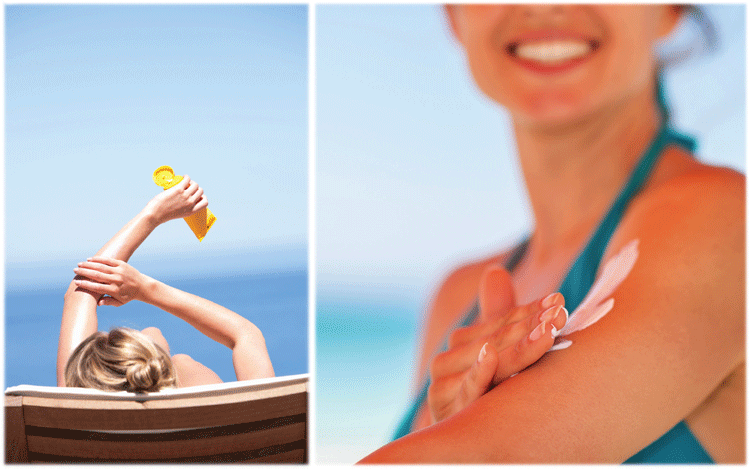A little skin protection knowledge now could save your life later
LIVING IN THE SUNSHINE STATE, we’ve all heard about the dangers of the sun’s ultraviolet (UV) radiation. However, it doesn’t seem as if we’ve learned enough, because the effects of sun exposure — like skin cancer — are posing as much danger to residents as ever. According to the Florida Department of Health (FDOH), the number of Americans with skin cancer in the last three decades is estimated to be higher than the number of those diagnosed with all other forms of cancer combined. Take the Central Florida Health News quiz to make sure you have all the information you need to protect yourself and your family from the sun’s damaging UV rays.
1. True or False? The sun’s UV rays are only doing damage to your skin when you get a sunburn.
2. What is the recommended method for avoiding damage from UV rays?
A. Wear a wide-brim hat that covers your face, ears, and neck as well as other clothing to cover your skin
B. Apply a broad-spectrum sunscreen (blocks UVA and UVB rays) with a minimum SPF of 15 or 30
C. Stay indoors or in the shade from 10 a.m. to 4 p.m.
D. Wear UVA and UVB-blocking sunglasses
E. All of the Above
3. What are the chances you’ll develop some form of skin cancer — such as UV radiation-caused melanoma — in your lifetime?
A. One in twenty
B. One in five
C. One in one hundred
D. One in fifty
4. True or False? Individuals with darker skin tones don’t need sunscreen.
5. Which of the following is true concerning kids and UV radiation from the sun?
A. Children average three times more sun exposure than adults
B. One sunburn that blisters doubles a child’s lifetime risk of developing skin cancer
C. Eighty percent of a person’s sun exposure is acquired before the age of 18
D. All of the Above.
6. True or False? You don’t need sunscreen during cloudy or overcast days.
7. Which of the following is NOT true of the Sunshine State and sun safety?
A. Florida’s sunshine contains more UV rays than other states because Florida is closer to the equator
B. You don’t need to apply sunscreen in the winter
C. Decking and concrete can reflect UV rays nearly as well as water, sand or snow
D. UV rays can reach you while driving
E. None of the Above
8. According to the FDOH, there will be approximately 5,480 new melanoma cases in Florida in 2015, and how many melanoma-related deaths?
A. 750
B. 275
C. 490
D. 820
9. What does a sunscreen’s SPF — Sun Protection Factor — indicate?
A. How many minutes longer a person can stand in the sun without burning than if they had no sunscreen on at all
B. The concentration of particles in the sunscreen (per million)
C. The number of hours of protection the sunscreen offers
D. None of the Above
10. What is the highest level of sunscreen SPF available?
A. SPF 100
B. SPF 50
C. SPF 30
D. SPF 75
ANSWERS
1. False. The sun’s UV rays are always doing damage to your skin. The effects range from wrinkles to skin cancer, so protection is a must.
2. E) All of the Above. It is recommended that you protect your skin and eyes from damaging UV rays in as many ways as possible.
3. B) One in Five. According to the FDOH, one in every five Americans will develop skin cancer.
4. False. Those individuals with darker skin tones can still suffer the UV damage and sunburns that lead to skin cancer.
5. D) All of the Above. Adults need to model good sun safety behaviors to help children minimize their own exposure to harmful UV rays.
6. False. While exposure to UV rays is lower on cloudy, overcast days, there is still radiation making its way through the clouds and damaging your skin as well as your eyes.
7. B) You don’t need to apply sunscreen in the winter. UV rays are weaker in the winter months, but they are still present. You always need to take steps to protect your skin and eyes.
8. D) 820. Melanoma is called the “deadliest skin cancer” because it goes undetected and spreads to other parts of the body.
9. A) How many minutes longer a person can stand in the sun without burning than if they had no sunscreen on at all. For instance, a sunscreen with an SPF of 30 allows you to remain unburned in the sun for 30 minutes longer than if you had no sunscreen on at all.
10. B) SPF 50. Sunscreens with SPF numbers higher than 50 are just marketing gimmicks that do not offer superior protection.
CREDIT
article by ERIKA ALDRICH
Resources: Information provided by the Sun Safety Alliance, Florida Department of Health, UF/IFAS Extension, and the Florida Society of Dermatology and Dermatologic Surgery.
